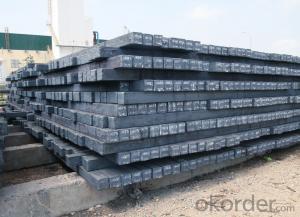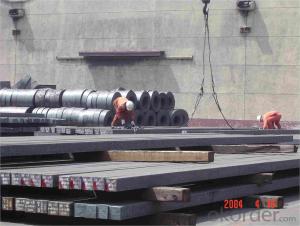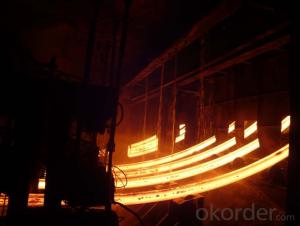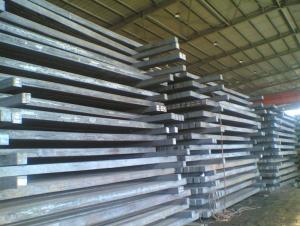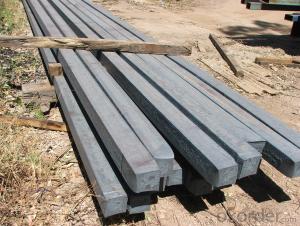Q235/3SP 160MM Blast Furnace Hot Rolled Steel Billet
- Loading Port:
- Tianjin
- Payment Terms:
- TT OR LC
- Min Order Qty:
- 2000 m.t.
- Supply Capability:
- 30000 m.t./month
OKorder Service Pledge
OKorder Financial Service
You Might Also Like
Description of Q235/3SP 160MM Blast Furnace Hot Rolled Steel Billet
Our hot dip galvanised steels consist of a steel substrate with a metallic zinc coating applied by means of a continuous hot dip galvanising process. Metallic zinc coatings are available in steel grades ranging from steel for bending and deep drawing applications, to structural steels and high yield strength steels.
A glossy surface finish obtained under specific skin-pass conditions (either non-skin-passed or skin- passed with smooth cylinders to obtain low roughness) can be provided if required at time of enquiry.
Advantage of Q235/3SP 160MM Blast Furnace Hot Rolled Steel Billet
Uncoated CR steel sheet With the features of in line with the international highest standards in demension and shape, excellent surface finish and properties, the products are mainly used in home appliance and automobile industries.
Galvanized steel sheet(include HDG and EG)
With the features of good corrosion resistance, the products are mainly used in automobile, home appliance, electronics, building and machinery manufacture industries, etc.
Precoated steel sheet With the features of enviromental protection and good processablility, long lasting surface durability, rich in colors, the products are maily used in building, home appliance and furniture industries, etc.
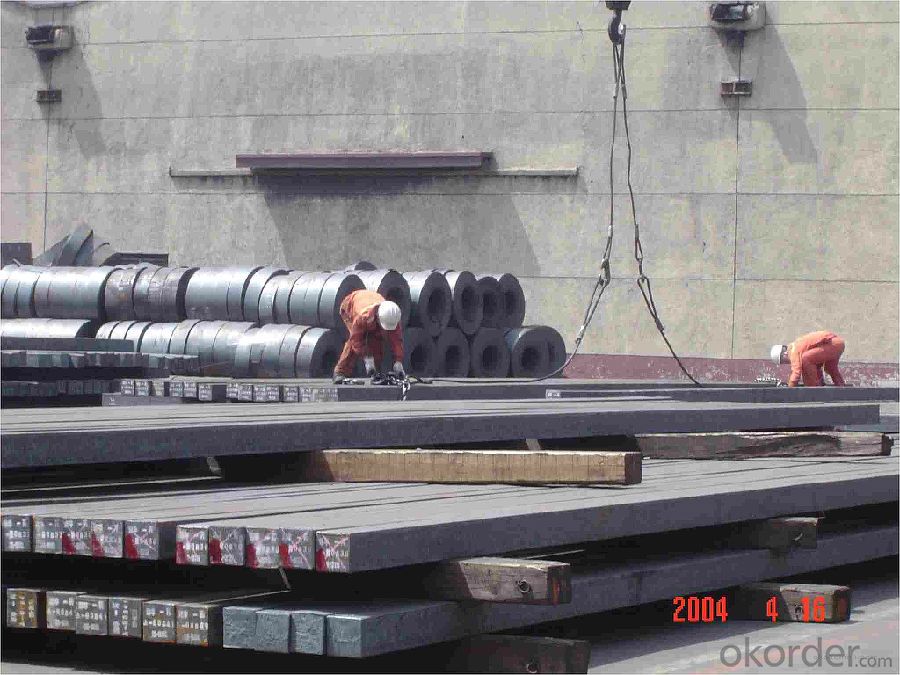
Applications of Q235/3SP 160MM Blast Furnace Hot Rolled Steel Billet
Our hot dip galvanised steels can be used in a very wide range of applications for industrial markets, both indoors and outdoors. Some of the most common applications are:
Building: wide sections for roofing and cladding, doors, door frames, metallic ceilings, partitions, structural members etc
Domestic appliances: all appliances for this sector (both white and brown goods) are manufactured with hot dip galvanised steels
Miscellaneous: electrical cabinets, aeraulic components, air conditioners, road signs etc
Zinc hot dip galvanised steel is suitable for contact with foodstuffs under certain conditions, as specified in European directive 89/109/EEC and French standard NF A 36-712-1. Please contact us for further information on this subject.
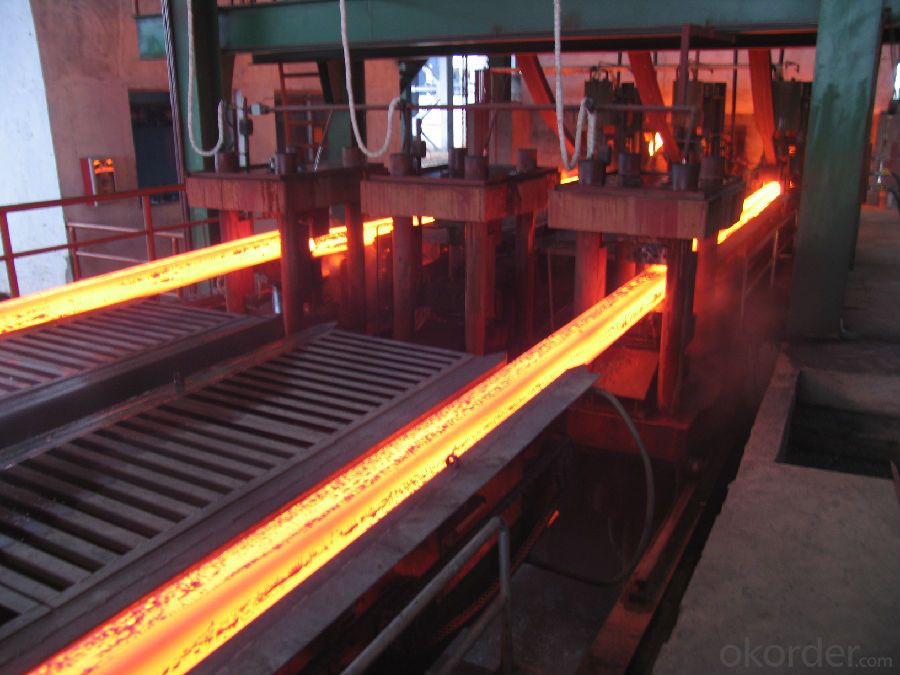
Specifications of Q235/3SP 160MM Blast Furnace Hot Rolled Steel Billet
Quality | Q/BQB 440-2003 | JIS G3312-1994 JIS G3321 | EN 10326-2004 | ASTM A653-02a |
EN 10327-2004 | (BASE PLATE) | |||
(BASE PLATE) | ||||
Commercial Steel | DC51D | SGCC SGLCC | DX51D+Z DX51D+AZ | CS Type A/B/C |
Forming Steel | St01,St02,St03 | SGCD1 SGLCD1 | FS Type A, Type B | |
Drawing | DC52D /DC53D | - | DX52D+Z DX52D+AZ | DDS TYPE A/C |
Steel | DX53D+Z DX53D+AZ | |||
Structural | S280GD (StE28) | SGC400 SGLC400 | S280D+Z DX54D+AZ | SS275 |
Steel | S350GD (StE34) | SGC440 SGLC440 | S350D+Z S350D+AZ | SS340 Class1 |
FAQ of Q235/3SP 160MM Blast Furnace Hot Rolled Steel Billet
We have organized several common questions for our clients,may help you sincerely:
1. How Can I Visit There?
Our company is located in Tianjin City, China, near Beijing. You can fly to Tianjin Airport Directly. All our clients, from home or aboard, are warmly welcome to visit us!
2. How Can I Get Some Sample?
We are honored to offer you sample.
3. Why choose CNBM?
Our delivery time about 15-20days for standard sizes, if you have other requirements like hardness, quanity and width ,it is about 20-40days. But don't worry we also try our best for the delivery time ,because time longer and our cost is higher.
- Q:What is the difference between a steel billet and a steel bar?
- A steel billet is a semi-finished product that is typically square or rectangular in shape and has a larger cross-sectional area compared to a steel bar. It is produced through the casting or rolling process and serves as raw material for further processing. On the other hand, a steel bar is a fully finished product that is typically round, hexagonal, or square in shape and has a smaller cross-sectional area. It is obtained by hot or cold working the steel billet through processes like rolling or drawing.
- Q:What are the main factors affecting the fatigue strength of alloy steel billets?
- The main factors affecting the fatigue strength of alloy steel billets include the composition of the alloy, the presence of impurities or defects, the heat treatment process, surface conditions, and the presence of residual stresses. Additionally, the applied load, frequency, and environmental conditions can also influence the fatigue strength of alloy steel billets.
- Q:What is the average price of steel billets?
- The average price of steel billets can vary depending on various factors such as the current market conditions, supply and demand dynamics, and the specific grade and quality of the steel billets. It is important to note that steel billet prices are influenced by global economic factors, including raw material costs, energy prices, and trade policies, which can lead to fluctuations in the average price. To get an accurate understanding of the average price of steel billets, it is recommended to refer to industry reports, trade publications, and market analysis platforms that provide up-to-date information on steel prices. Additionally, consulting with steel suppliers and manufacturers or engaging in negotiations with multiple sources can help determine the prevailing average price in a specific region or market.
- Q:What is the role of steel billets in the construction of railway stations?
- Steel billets are essential in constructing railway stations, serving as semi-finished steel products that are typically rectangular or square in shape. They function as raw materials for various construction purposes. Within the realm of railway stations, steel billets are primarily utilized to fabricate structural components like beams, columns, and trusses. These components provide the necessary strength and stability to support the weight of the station building, platforms, and any associated structures. A key advantage of employing steel billets in railway station construction lies in their high strength-to-weight ratio. Steel is widely recognized for its exceptional strength, making it an ideal material for supporting heavy loads. By incorporating steel billets, engineers can design and construct railway stations capable of enduring the constant traffic and heavy footfall characteristic of these public spaces. Furthermore, steel billets offer exceptional durability, corrosion resistance, and fire resistance, all of which are vital factors in ensuring the long-term safety and structural integrity of railway stations. These properties establish steel billets as a reliable and cost-effective choice for construction projects prioritizing safety and longevity. Moreover, steel billets can be easily shaped and fabricated into various sizes and dimensions, allowing for flexibility in design and construction. This versatility enables architects and engineers to create aesthetically appealing and functional railway station structures tailored to the specific project requirements. In summary, steel billets play a crucial role in railway station construction by providing the necessary strength, durability, and versatility required for the structural components supporting these vital transportation hubs. By utilizing steel billets, railway station construction projects can be completed efficiently, guaranteeing the safety and comfort of passengers for years to come.
- Q:How are steel billets used in the manufacturing of pipes?
- Steel billets are the initial raw material used in the manufacturing of pipes. They are heated and then passed through a series of rollers to form a cylindrical shape. These billets are then elongated and shaped into seamless pipes or welded together to create welded pipes. The high strength and durability of steel billets make them ideal for pipe production, ensuring the pipes can withstand high-pressure environments and various applications such as oil and gas transportation, plumbing, construction, and more.
- Q:How do steel billets contribute to the manufacturing of water and wastewater treatment equipment?
- Steel billets are used in the manufacturing of water and wastewater treatment equipment as they serve as the raw material for various components such as pipes, tanks, and structural supports. These billets are melted and shaped into the required forms, ensuring the durability and strength of the equipment. Additionally, steel billets can be further processed to create corrosion-resistant coatings, ensuring the longevity and reliability of the equipment in harsh water and wastewater environments.
- Q:How are steel billets used in the production of railway components?
- Steel billets are an integral part of the production process for railway components. These billets, which are essentially semi-finished steel products, are used as the raw material for manufacturing various railway components such as rails, wheels, axles, and other structural parts. To produce railway components, the steel billets are first heated to a specific temperature to make them more malleable. This heating process is crucial as it allows the steel to be easily shaped and formed into the desired component. Once the billets have reached the required temperature, they are then transferred to the next stage of the production process. Here, they are subjected to various processes such as rolling, forging, and machining to transform them into the final shape and size required for the specific railway component. For instance, in the production of railway rails, the heated steel billets are passed through a series of rolling mills where they are gradually shaped and elongated into the desired rail profile. Similarly, for the production of wheels and axles, the billets are forged and machined to achieve the required dimensions and surface finish. The use of steel billets in the production of railway components ensures that the final products are strong, durable, and capable of withstanding the heavy loads and stresses associated with railway operations. The quality and characteristics of the steel billets play a vital role in determining the performance and longevity of the railway components. Overall, steel billets are crucial in the production of railway components as they provide the raw material that is shaped, formed, and processed to create the final products that are essential for the safe and efficient functioning of the railway system.
- Q:What are the different packaging options available for steel billets?
- There are several different packaging options available for steel billets, depending on the specific requirements and preferences of the customer. Here are some common packaging options: 1. Wooden Crates: Steel billets can be packaged in wooden crates for protection during transportation and storage. These crates are sturdy and provide a barrier against moisture and physical damage. 2. Steel Frames: Another option is to package the steel billets in steel frames. These frames are typically made of strong and durable steel bars that securely hold the billets in place, providing stability and protection. 3. Plastic Wrapping: Steel billets can also be packaged using plastic wrapping. This method involves wrapping the billets tightly in plastic film, which helps to protect them from dust, moisture, and scratches. 4. Wire Binding: Wire binding is a common packaging option for steel billets. It involves using steel wires to bundle the billets together, providing stability and preventing movement during transportation. 5. Customized Packaging: Some customers may require customized packaging options for their steel billets. This can include using specific materials, such as foam or cardboard, to provide additional protection or incorporating branding elements onto the packaging. Ultimately, the choice of packaging option will depend on factors such as the size and weight of the steel billets, the mode of transportation, and the specific requirements of the customer. It is important to consider factors such as protection, stability, ease of handling, and cost-effectiveness when selecting the most suitable packaging option for steel billets.
- Q:What are the main factors affecting the formability of stainless steel billets?
- The main factors affecting the formability of stainless steel billets include the composition of the steel, the temperature at which it is being formed, the grain size and structure of the material, and the amount of deformation applied during the forming process. Firstly, the composition of the stainless steel billet plays a crucial role in its formability. Different grades of stainless steel have varying amounts of alloying elements such as chromium, nickel, and molybdenum, which affect the material's mechanical properties. For example, higher levels of chromium can increase the material's resistance to corrosion but may reduce its formability. Therefore, the choice of stainless steel grade is essential to ensure optimal formability for a specific application. Secondly, the temperature at which the stainless steel billet is being formed influences its formability. Stainless steel exhibits better formability at elevated temperatures due to increased ductility. Heating the billet helps to reduce its yield strength and allows for easier deformation. However, excessive heating can lead to grain growth and reduced mechanical properties, so it is crucial to find the right balance between temperature and formability. The grain size and structure of the stainless steel billet also affect its formability. Fine-grained materials tend to exhibit better formability compared to coarse-grained ones. Finer grains allow for more uniform deformation and reduced likelihood of cracking or tearing during forming processes. Additionally, the presence of certain microstructural features, such as precipitates or twins, can also impact the formability of stainless steel billets. Lastly, the amount of deformation applied to the stainless steel billet during the forming process affects its formability. Excessive deformation can lead to strain hardening, causing the material to become less ductile and more prone to cracking. Therefore, it is essential to carefully control the amount and distribution of deformation to ensure optimal formability. In summary, the main factors affecting the formability of stainless steel billets include the composition of the steel, the temperature at which it is being formed, the grain size and structure of the material, and the amount of deformation applied during the forming process. Understanding and controlling these factors is crucial for achieving the desired formability and ensuring successful manufacturing of stainless steel components.
- Q:How are steel billets used in the production of oil and gas machinery?
- Steel billets are used in the production of oil and gas machinery as a primary raw material for manufacturing various components, such as gears, shafts, valves, and casings. These billets are heated and shaped through processes like forging and rolling to create the desired shape and strength needed for the machinery. Additionally, steel billets provide the necessary durability and corrosion resistance required to withstand the harsh operating conditions in the oil and gas industry.
1. Manufacturer Overview |
|
|---|---|
| Location | |
| Year Established | |
| Annual Output Value | |
| Main Markets | |
| Company Certifications | |
2. Manufacturer Certificates |
|
|---|---|
| a) Certification Name | |
| Range | |
| Reference | |
| Validity Period | |
3. Manufacturer Capability |
|
|---|---|
| a)Trade Capacity | |
| Nearest Port | |
| Export Percentage | |
| No.of Employees in Trade Department | |
| Language Spoken: | |
| b)Factory Information | |
| Factory Size: | |
| No. of Production Lines | |
| Contract Manufacturing | |
| Product Price Range | |
Send your message to us
Q235/3SP 160MM Blast Furnace Hot Rolled Steel Billet
- Loading Port:
- Tianjin
- Payment Terms:
- TT OR LC
- Min Order Qty:
- 2000 m.t.
- Supply Capability:
- 30000 m.t./month
OKorder Service Pledge
OKorder Financial Service
Similar products
New products
Hot products
Related keywords
